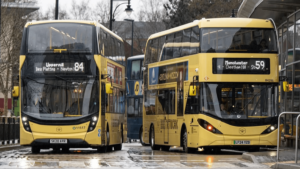Simon Jeffrey is a policy officer at the research unit Centre for Cities.
Last month, Jeffrey published a blog about the Clean Air Strategy. We spoke to him about why he thinks Clean Air Zones are a ‘missed opportunity’, the economic arguments for reducing cars in city centres, and why more cities should introduce a Workplace Parking Levy.
Do you think Clean Air Zones will achieve their aims?
I think Clean Air Zones are an important step for improving the air, but they’re a bit of a missed opportunity in the clear direction that was given to councils to help improve the economic performance of the areas that they cover.
From what we can see, cities that have taken steps in those CAZs to reduce the emissions seem to have done the bare minimum to get underneath the limit, which has meant that the non-air quality problems associated with lots of cars trying to get into the same space at rush hour haven’t been addressed.
Some people believe CAZs are a punitive tax on small businesses. Is this fair?
If your mission is to reduce the harmful emissions but you only force that onto taxis or businesses, then actually you might be having a really hard impact on those businesses in your area rather than dealing with the broader issues that private car journeys into a city centre equally impose on an area.
If you had a broader base tax which was focused on reducing the most polluting vehicles into a city and improving air quality but also on taking in that economic potential of Clean Air Zones to reduce car traffic and congestion, then it would be a lot less damaging to those businesses who are singled out.
There is the economic argument for reducing cars, but what about motorists who don’t live near any public transport routes?
If you have a car and live outside of a viable public transport area then that’s absolutely the right mode for your first leg of your trip, but then once you get into those areas where your car journey imposes costs of delay and greater air quality damage then the best strategy might be to have a park and ride system, or driving to a train station and parking there.
It’s not about saying people with cars are selfish, it’s saying that city centres don’t have the space for cars, which then affects the mobility of people who need to get in and out as freely as possible. What we could do is get some of the space free on our streets which would be positive for the economy and would be positive for air quality as well.
Maybe as cars improve, we could move to a future of zero tailpipe emissions, electric vehicles sooner. That doesn’t get away from some of the smaller particulate matter that comes from brakes and tires that also do a lot of damage to people’s health. These CAZs might have encouraged people to replace their current diesel vehicle with a cleaner electric vehicle, but that doesn’t mean that a traffic jam full of diesels is any less of an economic burden for people than a traffic jam full of electric cars.
You have said getting drivers out of cars and onto public transport should be a top public transport priority for local council leaders. Why do you think that they’re not doing more?
I think there are a few things in play. In terms of tools available, councils don’t have direct control over the buses directly, so they say, ‘We can’t franchise and devise an efficient bus system that offers the coverage and the service that would encourage people to get out of their cars,’
Or you hear councils say, ‘We can’t tell them to get out of their cars until we have a better alternative’, which is potentially a chicken and egg situation.
It’s understandable, but we’ve seen in London and Nottingham that through different approaches that make the cost of driving a bit higher, it opens up significant money for public transport and opens up room for a lot more productive use of land in city centres, like housing or commercial space.
Should other cities bring in a Workplace Parking Levy, like Nottingham?Â
It’s a difficult one because the Workplace Parking Levy came in with the Transport Act in 2000. Nottingham was the first place to use it in 2012 and since then no one else has used it despite what appear to be self-evident benefits like bringing in funding for public transport.
Nottingham have shown that you can get central government money if you show that you’re willing to make some tough decisions – introducing the Workplace Parking Levy raises about £9m a year now, and that gives you a revenue stream which you can borrow against. What places should be looking at is creating a funding stream at a time when there is not a lot of money around.
What can councils do to make Clean Air Zones and the wider clean air agenda more effective?
When cities are thinking about what they can do, they should have a really clear picture of the different road users in different parts of their cities – what is the benefit and the cost of those? It is from that that they should decide on how to improve air quality or support economic development using the Clean Air Zones. That will mean potentially the most polluting vehicles being hit hardest, but also those vehicles that are taking the most space at the most critical times.
If you want a successful city economy and a successful UK economy then traffic and no alternative is going to limit that. Cities should be thinking about dealing with that at the same time as dealing with clean air.
You can follow Centre for Cities’ work by visiting www.centreforcities.org.
















